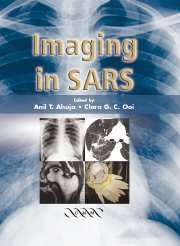Book contents
- Frontmatter
- Contents
- Contributors
- Preface
- 1 The Epidemiology of Severe Acute Respiratory Syndrome: A Global Perspective
- 2 The Role of Emergency Medicine in Screening SARS Patients
- 3 Severe Acute Respiratory Syndrome Outbreak in a University Hospital in Hong Kong
- 4 Imaging of Pneumonias
- 5 The Role of Chest Radiographs in the Diagnosis of SARS
- 6 Chest Radiography: Clinical Correlation and Its Role in the Management of Severe Acute Respiratory Syndrome
- 7 The Role of High-Resolution Computed Tomography in Diagnosis of SARS
- 8 The Role of Imaging in the Follow-up of SARS
- 9 Treatment of Severe Acute Respiratory Syndrome
- 10 SARS in the Intensive Care Unit
- 11 Imaging of Pneumonia in Children
- 12 Imaging and Clinical Management of Paediatric SARS
- 13 Imaging of SARS in North America
- 14 Radiographers' Perspective in the Outbreak of SARS
- 15 Implementation of Measures to Prevent the Spread of SARS in a Radiology Department
- 16 Aftermath of SARS
- 17 Update on Severe Acute Respiratory Syndrome
- Index
2 - The Role of Emergency Medicine in Screening SARS Patients
Published online by Cambridge University Press: 27 October 2009
- Frontmatter
- Contents
- Contributors
- Preface
- 1 The Epidemiology of Severe Acute Respiratory Syndrome: A Global Perspective
- 2 The Role of Emergency Medicine in Screening SARS Patients
- 3 Severe Acute Respiratory Syndrome Outbreak in a University Hospital in Hong Kong
- 4 Imaging of Pneumonias
- 5 The Role of Chest Radiographs in the Diagnosis of SARS
- 6 Chest Radiography: Clinical Correlation and Its Role in the Management of Severe Acute Respiratory Syndrome
- 7 The Role of High-Resolution Computed Tomography in Diagnosis of SARS
- 8 The Role of Imaging in the Follow-up of SARS
- 9 Treatment of Severe Acute Respiratory Syndrome
- 10 SARS in the Intensive Care Unit
- 11 Imaging of Pneumonia in Children
- 12 Imaging and Clinical Management of Paediatric SARS
- 13 Imaging of SARS in North America
- 14 Radiographers' Perspective in the Outbreak of SARS
- 15 Implementation of Measures to Prevent the Spread of SARS in a Radiology Department
- 16 Aftermath of SARS
- 17 Update on Severe Acute Respiratory Syndrome
- Index
Summary
Introduction
The Health Care System in Hong Kong was completely unprepared for the outbreak of severe acute respiratory syndrome (SARS) which occurred in March 2003. It challenged the entire medical system resulting in the temporary closure of emergency departments (EDs) (Figure 2.1) and hospitals. In the early stages, the illness affected an unusually high proportion of health care workers. The health care system was faced with many difficult issues including how and where to screen the hospital workforce and local community, and who should take responsibility for this screening task?
Emergency medicine is a systems-based, primary care speciality with skills and training to screen large populations of patients but its primary brief is to deal with acutely ill patients and not to provide a public health service. However, in the acute crisis brought about by the SARS outbreak, it was appropriate for the ED to take short-term responsibility to coordinate screening, as there were no other facilities available immediately.
This chapter reviews the challenges and responses involved in initiating and developing a SARS-screening clinic in an ED of a University Hospital in Hong Kong. While clinical features aid the assessment of patients suspected of having SARS, radiography supplemented by high-resolution computerized tomography (HRCT) is the cornerstone of SARS assessment.
- Type
- Chapter
- Information
- Imaging in SARS , pp. 17 - 28Publisher: Cambridge University PressPrint publication year: 2004

